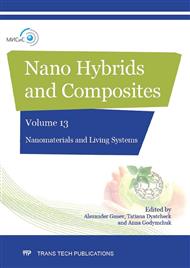[1]
Information on http: /www. nanotechproject. org, Project on Emerging Nanotechnologies, Woodrow Wilson International Centre for Scholar, Washington, USA.
Google Scholar
[2]
S. Prabhu, E.K. Poulose, Silver nanoparticles: mechanism of antimicrobial action, syntethis, medical applications, and toxity effects. International Nano Letters, 2: 32 (2012) http: /www. inl-journal. com/content/2/1/32.
DOI: 10.1186/2228-5326-2-32
Google Scholar
[3]
L.F. Espinosa-Cristobal, G.A. Martinez-Castanon, J.P. Loyola-Rodriguez et al. Toxicity, distribution, and accumulation of silver nanoparticles in Wistar rats. J. Nanopart. Res. 15: 6 (2013).
DOI: 10.1007/s11051-013-1702-6
Google Scholar
[4]
K. Loeschner, N. Hadrup, K. Qvortrup et al., Distribution of silver in rats following 28 days of repeated oral exposure to silver nanoparticles or silver acetate. Part. Fibre Toxicol. 8 (1), 18(2011).
DOI: 10.1186/1743-8977-8-18
Google Scholar
[5]
M. van der Zande, R.J. Vandebriel, D.E. Van et al.,. Distribution, elimination, and toxicity of silver nanoparticles and silver ions in rats after 28-day oral exposure. ACS Nano 6(2012).
DOI: 10.1021/nn302649p
Google Scholar
[6]
V.V. Nevzorova, I.V. Gmoshinskii and S.A. Khotimchenko, Problems of assessing the safety of nanomaterials used in food packaging, Vopr. Pitaniya, 2009, vol. 78, no. 4, p.54– 60.
Google Scholar
[7]
Y.S. Kim, J.S. Kim, H. S. Cho, D.S. Rha, J.M. Kim, J.D. Park, B.S. Choi, R. Lim, Y.H. Chung, I.H. Kwon, J. Jeong, B.S. Han, I.J. Yu, Twenty-Eight-Day Oral Toxicity, Genotoxicity and Gender-Related Tissue Distribution of Silver Nanoparticles in Sprague-Dawley Rats, Inhalation Toxicology, 20(2008).
DOI: 10.1080/08958370701874663
Google Scholar
[8]
I.V. Gmoshinski, S.A. Khotimchenko, V.O. Popov, B.B. Dzantiev, A.V. Zherdev, V.F. Demin, Yu.P. Buzulukov, Nanomaterials and nanotechnologies: methods of analysis and control, Russian Chemical Reviews 82 (1) (2013), 48-76.
DOI: 10.1070/rc2013v082n01abeh004329
Google Scholar
[9]
Yu.P. Buzulukov, I.V. Gmoshinskii, R.V. Raspopov et al., Study of absorption and biodistribution of nanoparticles of some inorganic substances introduced into the gastrointestinal tract of rats using radiotracers, Med. Radiol. Radiats. Bezopasn, vol. 57, no. 3(2012).
Google Scholar
[10]
Yu. P. Buzulukov, E. A. Arianova, V. F. Demin et al., Bioaccumulation of Silver and Gold Nanoparticles in Organs and Tissues of Rats Studied by Neutron Activation Analysis, 3590, Biology Bulletin, 2014, Vol. 41, No. 3, (2014) p.255–263.
DOI: 10.1134/s1062359014030042
Google Scholar
[11]
A.A. Shumakova, V.A. Shipelin, Yu.S. Sidorova, E.N. Trushina, O. K Mustafina, S.M. Pridvorova, I.V. Gmoshinskii and S.A. Khotimchenko, Toxicolgy Characterization of Nanoscale Colloidal Argentum Stabilized by Polivinilpirrolidon, Vopr. Pitaniya 2015, vol., no. 6, p.46.
Google Scholar
[12]
Y.K. Kim, Y. S. Moon, J. D. et al., Subchronic oral toxicity of silver nanoparticles, Particle and Fibre Toxicology 2010, 7: 20 www. particleandfibretoxicology. com/content/7/1/20.
Google Scholar
[13]
A.A. Antsiferova, Yu.P. Buzulukov, V.A. Demin, V.F. Demin, D.A. Rogatkin, E.N. Petritskaya, L.F. Abaeva, P.K. Kashkarov, Radiotracer Methods and Neutron Activation Analysis for the Investigation of Nanoparticle Biokinetics in Living Organisms, 2015, Rossiiskie Nanotekhnologii, 2015, Vol. 10, Nos. 1–2.
DOI: 10.1134/s1995078015010024
Google Scholar
[14]
V.A. Demin, V.F. Demin, Yu.P. Buzulukov, Formation of standard measurement guides and certified reference materials for gamma-ray spectroscopy and dynamic light scattering used for determination of weight fraction and size of nanoparticles in different media and biological matrixes, Nanotechnologies in Russia,. V. 8. No. 5–6(2013).
DOI: 10.1134/s1995078013030051
Google Scholar
[15]
H. J. M. Bowen, Trace Elements in Biochemistry. Academic Press, New York, (1966).
Google Scholar
[16]
ISO 11929: 2010. Determination of characteristic limits (decision threshold, detection limit and limits of the confidence interval) for measuring of ionizing radiation. Fundamental and application / ISO standard, (2010).
DOI: 10.3403/30166520u
Google Scholar


